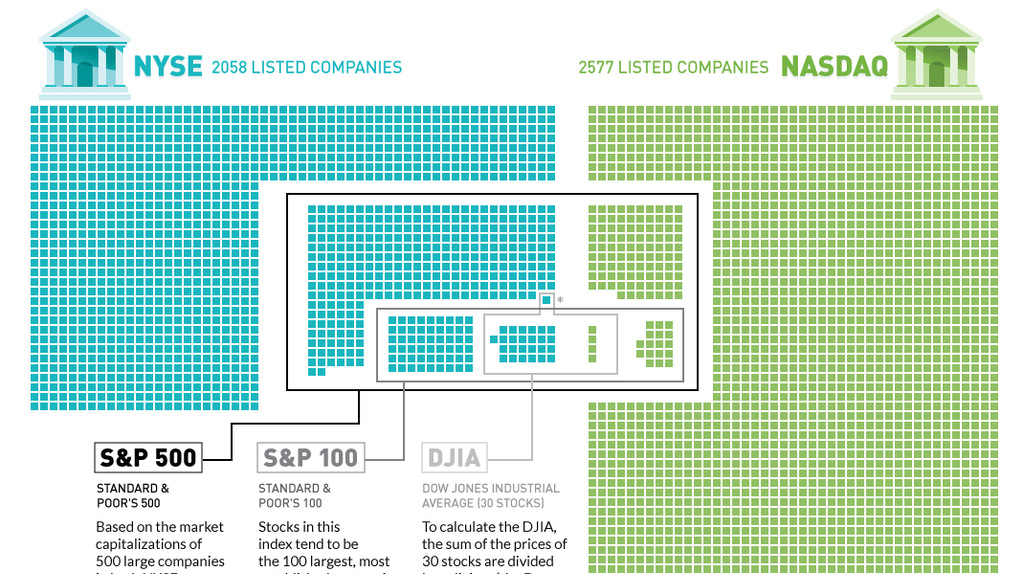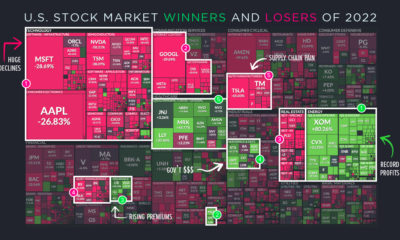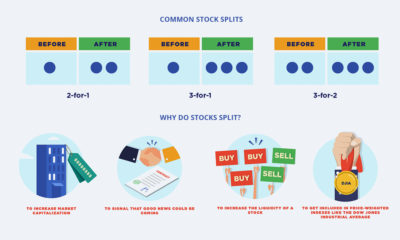The NYSE and NASDAQ are the two largest stock exchanges in the world by market capitalization. However, what is their relation to major indices such as the S&P 500, S&P 100, and the Dow Jones Industrial Average? Today’s chart breaks down the composition of the 4,500+ large cap stocks that are traded on the NYSE and NASDAQ, showing how the indices are currently derived. (For another refresher, check out our post on the difference between the Dow, S&P 500, and the NASDAQ.) The S&P 500, founded in 1923, is considered one of the best overall indicators of the U.S. stock market. Composed of 118 companies from the NASDAQ and 382 companies from the NYSE, it represents the 500 companies with the highest market capitalizations that have common stock listed on either exchange. The S&P 500 is a capitalization-weighted index with components weighted based on the total market value of their outstanding shares. The larger the company, the more the impact it will have on determining the price of the overall index. The S&P 100 is similar to the S&P 500, but it is composed of the 100 largest companies on the market, with 79 from the NYSE and 21 from the NASDAQ. Lastly, the Dow Jones Industrial Average is made up of 30 stocks, with 26 based on the NYSE and 4 based on the NASDAQ. The Dow ensures that it picks companies from every industry, while the S&P 100 picks the 100 largest companies by market capitalization. That’s why Travellers Companies Inc., at a market cap of $34 billion, is the only company on the Dow that is not on the S&P 100. on These are in the form of Treasury securities, some of the most liquid assets worldwide. Central banks use them for foreign exchange reserves and private investors flock to them during flights to safety thanks to their perceived low default risk. Beyond these reasons, foreign investors may buy Treasuries as a store of value. They are often used as collateral during certain international trade transactions, or countries can use them to help manage exchange rate policy. For example, countries may buy Treasuries to protect their currency’s exchange rate from speculation. In the above graphic, we show the foreign holders of the U.S. national debt using data from the U.S. Department of the Treasury.
Top Foreign Holders of U.S. Debt
With $1.1 trillion in Treasury holdings, Japan is the largest foreign holder of U.S. debt. Japan surpassed China as the top holder in 2019 as China shed over $250 billion, or 30% of its holdings in four years. This bond offloading by China is the one way the country can manage the yuan’s exchange rate. This is because if it sells dollars, it can buy the yuan when the currency falls. At the same time, China doesn’t solely use the dollar to manage its currency—it now uses a basket of currencies. Here are the countries that hold the most U.S. debt: As the above table shows, the United Kingdom is the third highest holder, at over $655 billion in Treasuries. Across Europe, 13 countries are notable holders of these securities, the highest in any region, followed by Asia-Pacific at 11 different holders. A handful of small nations own a surprising amount of U.S. debt. With a population of 70,000, the Cayman Islands own a towering amount of Treasury bonds to the tune of $284 billion. There are more hedge funds domiciled in the Cayman Islands per capita than any other nation worldwide. In fact, the four smallest nations in the visualization above—Cayman Islands, Bermuda, Bahamas, and Luxembourg—have a combined population of just 1.2 million people, but own a staggering $741 billion in Treasuries.
Interest Rates and Treasury Market Dynamics
Over 2022, foreign demand for Treasuries sank 6% as higher interest rates and a strong U.S. dollar made owning these bonds less profitable. This is because rising interest rates on U.S. debt makes the present value of their future income payments lower. Meanwhile, their prices also fall. As the chart below shows, this drop in demand is a sharp reversal from 2018-2020, when demand jumped as interest rates hovered at historic lows. A similar trend took place in the decade after the 2008-09 financial crisis when U.S. debt holdings effectively tripled from $2 to $6 trillion.
Driving this trend was China’s rapid purchase of Treasuries, which ballooned from $100 billion in 2002 to a peak of $1.3 trillion in 2013. As the country’s exports and output expanded, it sold yuan and bought dollars to help alleviate exchange rate pressure on its currency. Fast-forward to today, and global interest-rate uncertainty—which in turn can impact national currency valuations and therefore demand for Treasuries—continues to be a factor impacting the future direction of foreign U.S. debt holdings.
















